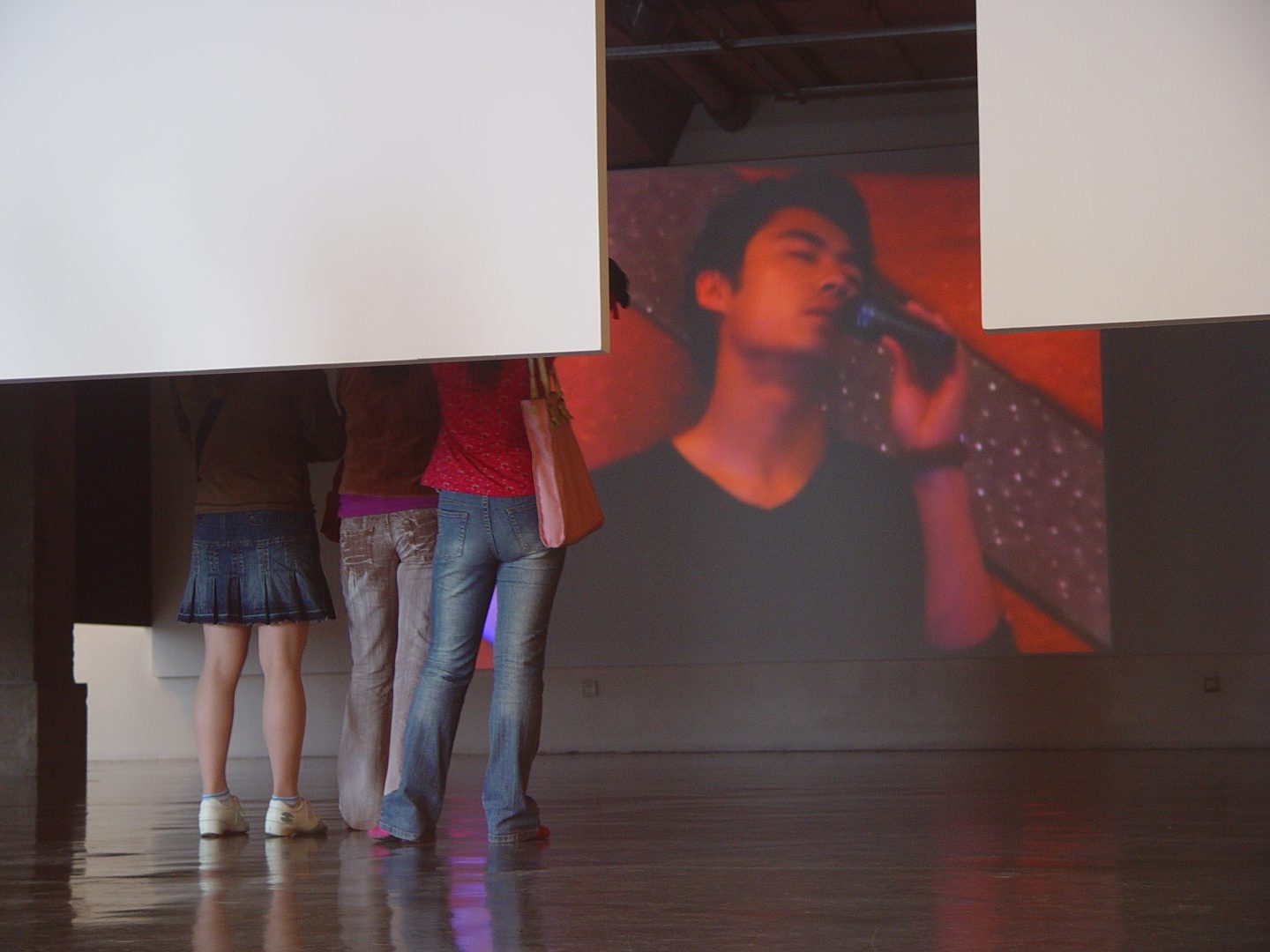Press Release
DODGE is a multimedia work consisting of 8 minutes of video, 2 photographs, installation and sculpture (Installation, Sculpture, Photo, Video 8minutes).
‘The concept of DODGE is derived from Borges’ Imaginary Creatures, in which he claims that the possibility of understanding the world is always uncertain. ‘DODGE suggests that a simultaneous state of mind and body provokes another way of seeing the world, one that is obscured and subversive. Between the everyday and the perverse, the habitual and the imaginary, a trust is used to stage a potentially evoked state of neutrality. The combination of different media, including architectural fragments (in the form of tilted skyscrapers), human archetypes, video projections, photography, and ‘dodging’ shakes up the boundaries between genres and creates a comprehensive visual landscape that reconfigures space and time. –Wang Jianwei
Wang Jianwei – DODGE
2006.5.20- 7.7
Wang Jianwei is an important figure within the contemporary Chinese art scene in that he is one of the very few artists investigating issues of public, society, and knowledge. Initially trained as a painter, Wang started to work in video, film and theatre since the middle of 1990’s and is reputed as an early pioneer for interdisciplinary art practice.
After graduated from high school in 1975, Wang was sent to the countryside for re-education. During this period, he observed peasants’ lives and their social conditions. During his study at the former Zhejiang Academy of Fine arts in Hangzhou from 1985 to 1987, Wang was heavily influenced by French existentialist figures like Camus and Satre. He soon questioned the adequacy of using painting to express his concepts. In 1991 Wang abandoned painting and started experimenting with new media and made his first video in 1995. In 1997, Wang was one of two Chinese artists to be included in Documenta 10 held at Kasel, Germany.
Referenced from the writings by Argentine writer Jorges Luis Borges, Wang often uses the city as the backdrop for probing our complex relationships with knowledge, history, philosophy, power, and cultural production. While not entirely interested to deliver a singular message to the audience, Wang’s situational practices critique the many different forms of cultural production within the private and public spheres. Wang states his intention: “I consider myself to be a sociological observer, in the same way as when I worked with theatre. I am not interested in knowing if my work is that of an artist or not, but it becomes a form of experimentation.” His cross-disciplinary art practice with theatre, performance and new media is apparent in a work titled “Ceremony” (2003) which was presented at the Pompidou Centre in Paris and at the Institute of Contemporary Art in London. His video “Spider” (2004), made specifically for the inaugural exhibition of SGA, documents various masked characters inside an internet control building and brings to the fore issues of information control and social conformity.
A more recent project titled Flying Bird is Motionless (2005) proposes multiple interpretations of a given process. Taken from Greek Philosopher Zenon’s claim that a flying arrow is in fact motionless throughout its entire trajectory [on the basis that time is composed of isolated moments] and using the epic of yangjiajiang from the Song dynasty as a narrative for his video, Wang restages a popular fighting scene inside a closed yet generic interior. By given different roles to play, the actors are instructed to kill one another. In particular, Wang is interested in the way in which the actors disrupt a given narrative with their own actions and in doing so creates a “non-site” that is devoid of any meaning, this can be read as a metaphor for expressing a deep sense of amnesia in contemporary Chinese society.
Wang’s new project is titled DODGE. The concept of DODGE is originated from the Book of Imaginary Beings by Borges who claims that the possibilities for understanding the world are always uncertain. DODGE stages a spiritual and physical state for provoking new ways of perceiving the world, a potential state that is neutral yet highly provocative, in between conventional and imaginary, everyday and abnormal. DODGE is composed of different media which includes architectural fragments [in the form of a toppled skyscraper], human prototypes, video projection, and photography. The video installation documents multiple actors and actresses traversing different spaces inside a karaoke bar, a train station and a hospital, while the hollow interior of the toppled skyscraper with a bodily interior draws direct visual reference to the architectural design of the atrium inside the gallery as well as a staircase inside the video. By staging a situation for inter-relativity, Wang destabilizes the boundaries between different genres and creates an overall visual landscape that reconfigures time and space altogether.
David Chan
Artist’s statement
“In the Book of Imaginary Beings written by argentine writer Jorge Luis Borges, monsters are merely parts for real life… they provide us with another view for looking at the world, that is the possibilities for understanding the world as a series of uncertain relationships. “Dodge” embodies such a spiritual and physical state, a description in between convention and unconventionality, the everyday and the abnormal, an intermediate phenomenon, an imagination of something uncertain?
“Dodge” is an in-situ project that is composed of different media: architectural fragments, ambiguous biological models, a re-configuration of time and moments, a situation for paralleling different activities in overlapped spaces… This concept is originated from theatre, literature, psychology, and daily life, therefore transforming different concepts into a visual landscape.”
Wang Jianwei
-1440x1166.jpg)


